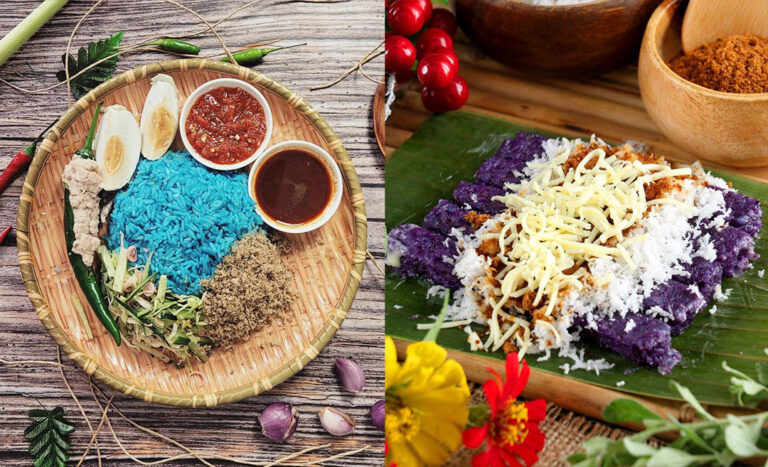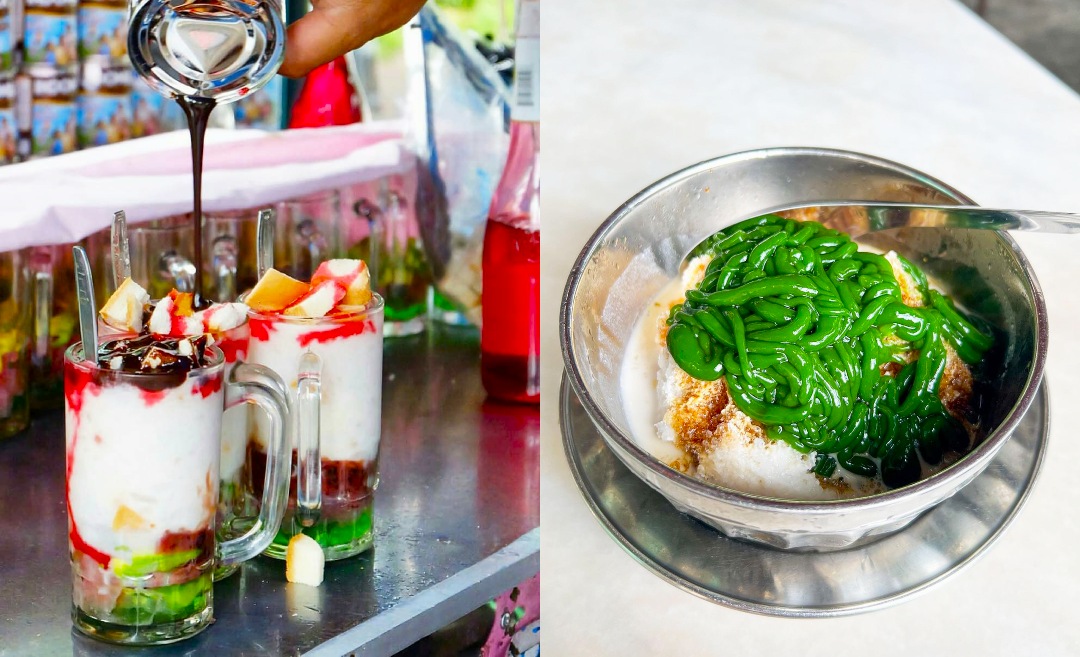Rice may not taste like much on its own, but without it, many Southeast Asian meals would be incomplete. Nothing else cuts it quite like rice when it comes to soaking up spicy curries and other amplifying flavours.
Mildly nutty and extremely versatile, the region’s favourite grain lends itself to both savoury and sweet delights and a variety of cooking techniques, from steaming to stir-frying over a high flame. Starchy and sticky or light and fluffy, rice brings comforting dishes together, and the possibilities are endless.
Nasi goreng rawon
This rice dish takes the enjoyment of rawon, an East Javanese beef soup, to the next level. After all, how can you go wrong when you combine a rich soup that draws its nutty flavour from dark kernels of keluak with fried rice, one of Indonesia’s national dishes? To make nasi goreng rawon, the earthy keluak seed, with its mild, almost cocoa-like bitterness, is sautéed with bruised lemongrass, lime leaves, and galangal until fragrant.
Cumin, cardamom, turmeric, ginger, coriander powder, red chillies, shallots, and garlic are then blended and added to create the spice paste, which is used to season and fry thin slices of beef and rice. Nasi goreng rawon is typically served with raw bean sprouts, thinly sliced shallots and leeks, salted egg, and emping (crackers).
Hainanese curry rice
While Singapore is famous for its Hainanese chicken rice, another local favourite also deserves the limelight—the messy, insanely delicious Hainanese curry rice. This speciality traces its roots to the British colonial period when Hainanese chefs serving in British and Peranakan Chinese households adapted recipes from both cultures and created a range of unique dishes, such as chicken chops.
Hainanese curry rice is basically fluffy white rice sloppily drenched in a mild coconut milk-rich curry perfumed with cinnamon and star anise, and drizzled with sweet and sticky braised black sauce for depth of flavour. Add to this thin slivers of crisp deep-fried pork chop – sometimes cut with a pair of scissors – as well as braised cabbage with crunchy shrimp, and you have a winner.
Other sides include braised hard-boiled eggs, pork belly, and chicken wings. But really, the rice and curry alone are enough to have you coming back for more.
Nga cheik paung
In Myanmar, steamed nga cheik paung, or black sticky rice, is a popular savoury breakfast eaten with a variety of toppings. The glutinous rice is actually a dark purple hue and is known for its nutty, almost vanilla flavour and chewy bite.
You can choose what you want with your nga cheik paung but typically, it is eaten with toasted sesame seeds, crispy fried onions, garlic-infused oil, shavings of fresh coconut meat, dried Bombay duck, and nutritious pe byouk or sprouted yellow peas.
When boiled, these peas have been likened in taste and texture to English mushy peas. This savoury street eat, bursting with texture and flavour, is typically washed down with green tea or lahpet yay cho (hot milk tea).
Nasi kerabu
Every mouthful of this blue-tinged herb rice dish from peninsular Malaysia’s East Coast is an explosion of flavour and texture. The rice itself is steamed with aromatics like lemongrass, galangal, ginger, and kaffir lime leaves, together with a natural blue extract obtained by steeping bunga telang or butterfly pea flowers in hot water.
The complete package includes a salted egg, fish crackers, toasted grated coconut, and fish flakes, and ulam—a bouquet of finely shredded herbs like mint, lemongrass, laksa leaf, and torch ginger, as well as vegetables such as long beans and cabbage.
Popular accompaniments include solok lada – green chillies stuffed with mackerel paste and grated coconut – and flavourful ayam percik, grilled chicken coated in a creamy spiced sauce made with lemongrass, galangal, turmeric, chilli paste, tamarind, and splashes of coconut milk.
Kralan
Kralan, or bamboo sticky rice, is a popular treat in Cambodia, where it is peddled everywhere, from markets to roadside stalls. Owing to the ease of eating it – basically, peeling the shaven bamboo strips back like a banana – it’s great for snacking on the go.
The sticky rice is mixed with coconut milk or cream, grated coconut, palm sugar, black beans, and a little salt, then filled into a bamboo stalk, corked with coconut husk and roasted over a charcoal fire for one to two hours. Afterwards, the charred outer layer of the bamboo skin is removed, leaving the inner tube that can be easily stripped off, revealing the sweet-salty, smokey and extremely filling delight.
Nam khao
A healthy rice salad enjoyed in Laos and northern Thailand, where it’s called yam naem, this dish is a fresh, zesty treat that’s big on flavour. What’s more, you won’t feel as though you’re just eating leaves and missing out on the pleasures of life. The highlight of this salad is its lightly curried rice croquettes made with jasmine rice, shredded coconut meat, red curry paste, and kaffir lime leaves, which are battered and fried until golden brown.
The crispy rice balls are then crumbled and tossed with fried chillies and peanuts, scallions, raw ginger, pennywort leaves, mint, Vietnamese coriander, pig skin, and naem, a fermented pork sausage. The salad is dressed with bright splashes of fresh lime juice and fish sauce and is typically eaten wrapped in lettuce leaves topped with dried chillies. Each bite is packed with heat from the chillies and sweet spice from the ginger, and laced with citrus zestiness. The aromatic rice, with its almost cereal-like crunch, brings all the bold flavours together.
Puto bumbong
This sweet sticky rice treat is especially popular in the Philippines around Christmas when it is sold outside churches after the devotional nine-day dawn masses called Simbang Gabi. Its gorgeous deep purple hue comes from a variety of glutinous rice called pirurutong. These days, vendors often use glutinous rice flour tinted purple with ube (yam) or food colouring, but authentic recipes still call for this unique heirloom rice.
The violet-hued pirurutong is soaked with regular sticky rice and ground until slightly grainy. The sticky mixture is then filled into bumbong or bamboo tubes and steamed for about 10 to 20 minutes. To serve, the logs of purple sticky rice are placed on banana leaves, brushed with butter, and topped with muscovado sugar and freshly grated coconut. This treat is best eaten warm, with the butter melting over the sticky rice cake.
More luxe versions include toppings like cheese curls, condensed milk and creamy leche flan.
Lo mai gai
If you love the chewy texture of glutinous rice, you’ll love lo mai gai, an aromatic dim sum classic of steamed sticky rice studded with shiitake mushrooms, chicken and sweet-savoury Chinese sausage. To prepare this dish, rice is first soaked for at least four hours to ensure the grains remain intact while retaining their stickiness. It is then fried with shallots, garlic, five spice powder and light and dark soya sauce before being steamed to seal all those intense flavours.
The rice is portioned into bowls, already holding goodies like Chinese sausage, stir-fried shiitake mushrooms, and slivers of chicken marinated with Shaoxing wine, oyster sauce, sesame oil, white pepper, and ginger juice. A second round of steaming ensures the compacted rice is infused with all that umami goodness. To serve, the bowl is inverted to reveal the glistening treat.
This story by Beverly Rodrigues was originally published on AirAsia. Zafigo republished this story in full with permission from the publisher, simply because good stories should be read by as many people as possible! If you have stories that will be of interest and useful to women travellers, especially in Asia, please get in touch with us at [email protected].




